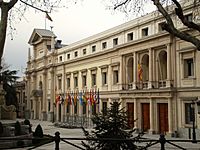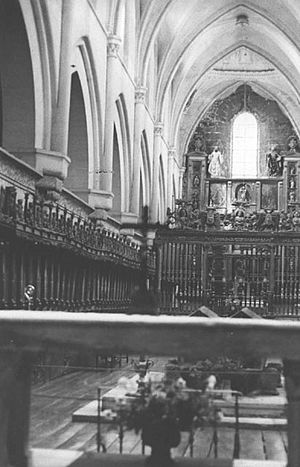National Council of the Movement facts for kids
Quick facts for kids National Council of the MovementConsejo Nacional del Movimiento |
|
|---|---|
 |
|
| Type | |
| Type |
Advisory Body
|
| History | |
| Established | 19 October 1937 |
| Disbanded | 16 June 1977 |
| Meeting place | |
 |
|
| Palace of the Senate, Madrid | |
The National Council of the Movement (in Spanish: Consejo Nacional del Movimiento) was an important group during the time of the Franco dictatorship in Spain. It was like an advisory board that helped the Head of State, Francisco Franco.
This council was first created on October 19, 1937, during the Spanish Civil War. It was originally called the National Council of FET y de las JONS. It continued to exist until 1977, after Franco's death, when his government's institutions were being changed.
The way the council was set up was inspired by similar groups in Italy. It had up to 50 members, called councillors. Franco chose the first members in 1937. These members came from different political groups that had supported the military uprising in 1936. These groups had been brought together by Franco in April 1937 under the name Falange Española Tradicionalista y de las JONS (FET y de las JONS).
The council first met in December 1937 at the Monastery of las Huelgas in Burgos. After the Civil War ended, they met in the old Palace of the Senate in Madrid. Like other parts of Franco's government, the National Council was officially ended just before the elections in 1977.
History of the Council
How the Council Started
The National Council of the Traditionalist Spanish Falange and the JONS (FET y de las JONS) was formed by a special rule called the Unification Decree. This decree created the only political party allowed during the Franco dictatorship. The new council was based on an older group called the National Council of the Spanish Falange of the JONS. This group had joined with another traditionalist group to form FET y de las JONS.
The Unification Decree said that the main parts of this new political group would be the Head of State (Franco), a special office called the Political Board, and the National Council. The decree explained that the Council would learn about important national issues that the Head of State wanted them to know about.
The decree also set up a Political Secretariat. This group was meant to guide the new organization. It included important members from the Falangist and traditionalist groups, and Francisco Franco was its leader.
On August 5, 1937, Franco announced the rules for FET y de las JONS. He said it was "the inspiring Movement and base of the Spanish State." The rules explained that the Movement would have three types of active members:
- Militants: These were people who already belonged to political groups before the unification.
- Military: All active generals, chiefs, officers, and soldiers in the Army were automatically members.
- Adherents: These were new people who joined and had to prove they could serve before becoming full militants.
Regarding the National Council, the rules stated it would include the National Chief (Franco himself), the president and vice president of the Political Board, the head of the Militias, and leaders of different party services. Franco could also choose up to twelve more members based on their importance in the State or for their special achievements. Franco was the leader of the Council. He was the only one who could call meetings and decide what topics would be discussed. The Council's job was to "know" (not to make decisions about) the plans for the Movement and the State, as well as any big national issues that Franco brought to them.
First Meeting of the Council

In November 1937, General Franco chose the fifty members of the National Council. Most of these members were Falangists, a political group that supported Franco's ideas. There were twenty-six Falangists. There were also eleven Carlists, a group that supported traditional monarchy, and six monarchists. Six soldiers completed the fifty members.
The very first meeting of the National Council of FET y de las JONS happened on December 2, 1937. It took place at the Monastery of Las Huelgas in Burgos. The Council had 50 members and brought together different political views. Most of them were older Falangists or new Falangists, making up more than half of the members.
The Council also included traditionalists, monarchists, and military leaders. Some well-known members included Pilar Primo de Rivera, Agustín Aznar, and Juan Yagüe.
See also
 In Spanish: Consejo Nacional del Movimiento para niños
In Spanish: Consejo Nacional del Movimiento para niños

